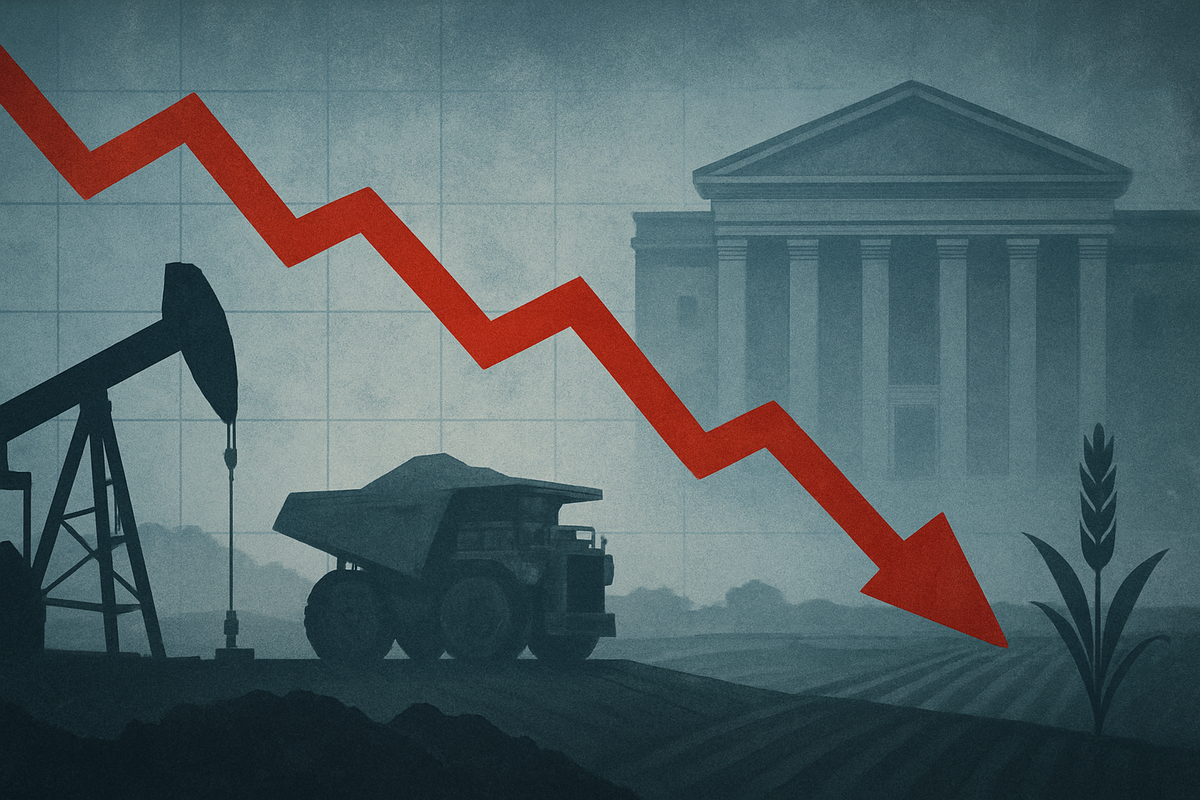Commodity Headwinds and Hawkish Fed Drag Down Global Markets, Toronto's TSX Bears the Brunt
By:
MarketMinute
November 14, 2025 at 14:47 PM EST

Toronto, ON – November 14, 2025 – Global financial markets are currently navigating a turbulent period, grappling with the twin forces of declining commodity prices in several key sectors and a decidedly hawkish stance from the U.S. Federal Reserve. This confluence of factors has significantly dampened investor sentiment, leading to widespread market corrections and particularly impacting resource-heavy exchanges like the Toronto Stock Exchange (TSX). Hopes for imminent interest rate cuts, once a beacon for market optimism, have rapidly faded, replaced by the stark reality of a "higher for longer" interest rate environment. The immediate implications are clear: increased market volatility, a "risk-off" sentiment dominating trading floors, and a re-evaluation of asset valuations across the board. While some commodities, such as crude oil and natural gas, have seen recent upticks due to geopolitical tensions and weather forecasts, precious metals and industrial metals are experiencing significant downward pressure. This divergence, coupled with the Fed's firm hand, has sent ripples through global equities and bond markets, forcing investors to recalibrate their expectations for economic growth and monetary policy. The Unfolding Market Correction: A Detailed AccountThe current market downturn is the culmination of a series of events and policy shifts that began in late 2024 and intensified throughout 2025. The narrative has been shaped by a cautious Federal Reserve, fluctuating commodity markets, and significant geopolitical and trade policy developments. Timeline of Key Events:
Key Players Involved: The Federal Reserve has been at the epicenter of this shift, with Chair Jerome Powell setting a hawkish tone. Other influential Fed officials include Beth Hammack (President, Cleveland Federal Reserve Bank), Alberto Musalem (President, St. Louis Federal Reserve Bank), Neel Kashkari (President, Minneapolis Federal Reserve), and Mary Daly (President, San Francisco Federal Reserve), all of whom have emphasized caution regarding rate cuts and the need to combat persistent inflation. On the commodity front, OPEC+, led by Saudi Arabia and Russia, has played a significant role by gradually increasing oil output, contributing to an anticipated supply surplus. U.S. President Donald Trump's tariff policies in April 2025 were a direct trigger for a major market crash and continue to influence global trade dynamics. Initial Market Reactions: The market reactions have been swift and broad-based. Equities have seen widespread sell-offs, particularly in the technology sector, with major tech and AI-linked stocks like Palantir (NYSE: PLTR), Nvidia (NASDAQ: NVDA), Micron (NASDAQ: MU), and Western Digital (NASDAQ: WDC) leading the decline. Financials initially struggled as the prospect of fewer rate cuts limited net interest income expansion but may find some benefit from higher-for-longer rates. Bonds and Treasuries experienced a flight to safety initially, but then widespread selling pushed yields higher as rate cut hopes faded. Commodities have been divergent: oil became a "main loser" through much of 2025, though recent geopolitical events have provided some support; natural gas has been an outperformer; and precious metals like gold and silver plummeted on November 13-14, with gold falling to as low as $4,034.54 per ounce. Winners and Losers on the TSX: A Sectoral Deep DiveToronto's TSX, with its substantial weighting in resource sectors, is particularly sensitive to these shifts. The combination of a hawkish Fed, fading rate cut hopes, and mixed commodity prices is creating clear winners and losers among public companies. Energy Sector:
Mining Sector:
Financials Sector:
Wider Significance: A Global ReassessmentThese market shifts are not isolated events but rather integral parts of broader industry trends and carry significant ripple effects across the global economy. Broader Industry Trends: The global economy is transitioning from a period of acute supply-side shocks to a slowdown driven more by demand-side factors. Inflation, particularly in the U.S., has proven "stickier" than expected, hovering around 3%, well above the Fed's 2% target. This necessitates a "monetary policy normalization" rather than rapid easing, leading to subdued global growth. The increased market volatility and divergence in commodity performance, coupled with the lingering impact of U.S. tariffs, underscore a highly uncertain environment. There are also growing concerns about the sustainability of the AI-driven market rally, contributing to recent equity weakness. Potential Ripple Effects:
Regulatory or Policy Implications: Governments will face pressure to implement fiscal policies that complement monetary tightening without stifling growth. Trade policy escalation, particularly U.S. tariffs, risks retaliatory measures and higher domestic inflation. There could be increased scrutiny on commodity market speculation. Proposals like those in "Project 2025" advocating for weakened oversight of financial markets and restrictions on the Federal Reserve's "lender-of-last-resort" function could foster financial risk. Historical Precedents: The current environment draws parallels to the "Taper Tantrum" of 2013, where a hawkish Fed and a strengthening dollar created headwinds for commodities. The early 1980s (Volcker Era) also saw aggressive monetary tightening coincide with corrections in precious metal prices. The 1990s monetary tightening phases similarly impacted precious metals. These historical examples underscore the sensitivity of markets to shifts in central bank policy and the inverse relationship between real interest rates and non-yielding assets. The 2020s have already proven to be the most volatile decade for commodity prices since the 1970s. What Comes Next: Navigating the New NormalThe path ahead for markets and industries will be defined by continued adaptation to a landscape fundamentally altered by persistent inflation and a hawkish monetary policy. Short-Term Possibilities: Expect continued equity market volatility, especially in high-growth sectors. Bond yields will likely remain elevated as the "higher for longer" narrative solidifies. Commodity markets will continue to diverge, with precious metals facing headwinds while energy prices remain sensitive to geopolitical events. Highly leveraged companies will face increased debt servicing costs, and consumer discretionary spending may slow. Long-Term Possibilities: The "higher for longer" interest rate environment is expected to persist, leading to slower global growth. Businesses will need to prioritize financial discipline, tangible profitability, and realistic valuations over aggressive growth. Inflationary pressures from geopolitical tensions and supply chain disruptions may continue. Structural shifts in commodity demand, driven by the low-carbon transition, will see metals for renewable energy gain importance, while fossil fuel demand may sag. Strategic Pivots and Adaptations:
Market Opportunities and Challenges:
Potential Scenarios:
Comprehensive Wrap-Up: Navigating a Period of Profound ChangeThe financial landscape as of November 14, 2025, represents a critical juncture. The Federal Reserve's unwavering commitment to combating inflation, coupled with a mixed but often downward-pressured commodity market, has ushered in an era of "higher for longer" interest rates. This marks a profound shift from the preceding period of readily available cheap money, demanding a fundamental recalibration of investment and operational strategies. The key takeaways are clear: the Fed is hawkish, rate cut hopes have diminished, and precious metal prices are feeling the pinch, while other commodities show divergent trends. This has led to significant market volatility, particularly impacting equity markets. Moving forward, investors must prepare for sustained uncertainty and adjust their portfolios accordingly. Focus on companies with strong fundamentals, reassess risk exposure, and maintain a granular view on commodity markets. The lasting impact of this period will likely be a more disciplined and selective market environment. The ability of the Fed to maintain its independence and data-driven approach, even amidst political and market pressures, will be crucial for its long-term credibility. Investors should remain agile, patient, and vigilant, closely monitoring economic data, central bank communications, and geopolitical developments in the coming months. The era of easy gains is likely over; the new normal demands strategic foresight and robust risk management. This content is intended for informational purposes only and is not financial advice More NewsView More
D-Wave: Time to Buy the Dip? Or is the Fall Just Starting? ↗
Today 18:55 EST
Via MarketBeat
Tickers
QBTS

Hims, Block, and NRG Just Launched Huge Stock Buybacks ↗
Today 17:32 EST
Via MarketBeat

Retail Earnings Roundup: Walmart Scores, Target Slumps in Q3 ↗
Today 16:45 EST
Via MarketBeat

Via MarketBeat

Via MarketBeat
Recent QuotesView More
Stock Quote API & Stock News API supplied by www.cloudquote.io
Quotes delayed at least 20 minutes. By accessing this page, you agree to the Privacy Policy and Terms Of Service.
© 2025 FinancialContent. All rights reserved.
|